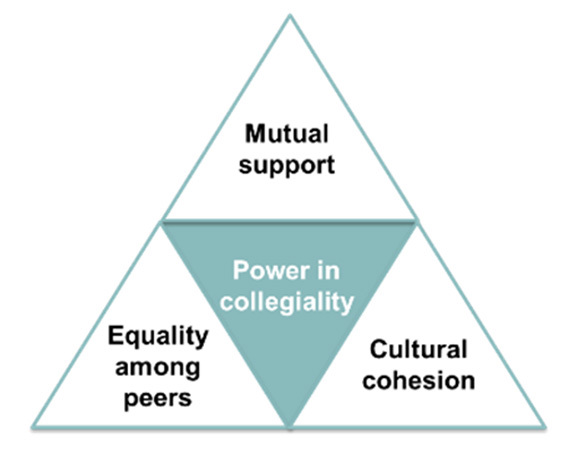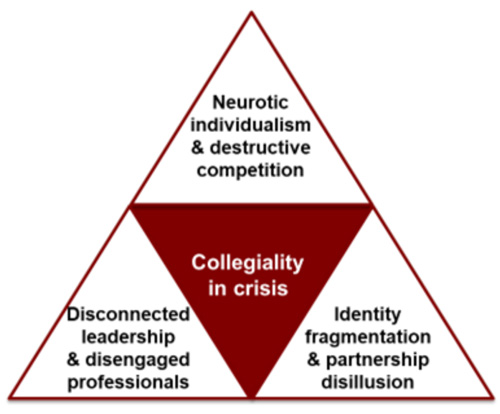Latest thinking
Follow me on Linkedin to be notified of my latest articles, podcasts and research papers as soon as they are published.
Follow
Offices are half empty. Partners are burnt out. And who exactly are these new people who joined the partnership during the pandemic? What has happened to the glue that once bound the partners together?
These are questions I frequently hear from leaders of the professional organizations that I work with. The crisis of the pandemic united colleagues in a common purpose – and innovation and adaptation proceeded at a remarkable pace. But now the crisis has passed, what is left? Whatever happened to collegiality and how can it be revitalised?
While professionals are quick to invoke the concept of collegiality they may struggle to define it. As one professional said to me:
“Collegiality is held out as something partners should be – one of those intangible things that is hard to pin down – the ability to respect peoples’ points of view, especially if you don’t agree with them – something to do with fit – being prepared to sacrifice yourself for the greater good. I’ve never really thought about it actually, in spite of it being a word I’ve heard every day of my professional life.”
My research has identified three core components of collegiality.
This is where most professionals start when they seek to explain collegiality - the relationship between colleagues united in a common purpose, the warm and fuzzy feelings professionals may have for colleagues they have known for many years, the belief that “he ain’t heavy, he’s my brother (or sister)”, which seems to represent partnership at its best. But this is only one component of collegiality.
As important, or perhaps even more so, is the idea of equality among peers. The term “collegia” comes from Ancient Rome. The collegia were the loosely governed associations of like-minded colleagues, working together as peers and united by a common practical purpose. Collegia were formed for multiple reasons – by businessmen, craftsmen, priests and priestesses, and even criminals. Leaders were elected and decisions were made collectively.
The final element of collegiality is cultural cohesion, which makes consensus-based decision making among peers more effective. In the most cohesive cultures there is agreement not just on a common purpose but on the beliefs and behaviours that bind the community together. The need for formal control is light because informal cultural controls ensure professionals are self-regulating. This makes it easier for colleagues to fulfil their commitment to mutual support.
So all three elements – mutual support, equality among peers, and cultural cohesion – are inextricably connected. When all three are strong, there is enormous power in collegiality. Senior professionals are united and invigorated, collaborating in business and leading collectively.
However, as my research has found, if any one of these three elements is weakened, collegiality can lose its potency.

In driving for improved financial performance, mutual support can give way to neurotic individualism and destructive competition.
In concentrating authority to improve efficiency, equality among peers can develop into disconnected leadership and disengaged professionals.
And in building a more diverse mix of businesses, geographies, and people, cultural cohesion can give way to identify fragmentation and partnership disillusion.
So whilst collegiality is intensely practical and powerful, it is also fragile.
Collegiality involves making difficult choices. When to support a colleague and when to withdraw? How much equality is too much? How to be inclusive and expansive whilst retaining the exclusivity that cohesiveness demands?
So when the leaders of professional organizations look to me for help, telling me their partners have lost their mojo post pandemic, and that their culture is under threat from changing working practices, I start with three core questions:
Collegiality is not something that can be taken for granted. It is bound up with ideas of collaboration, but it goes deeper than that. It is about culture and power, but above all about the kind of organization you want to be. Understanding collegiality and working out how to strengthen and sustain it is key to revitalising partnership.

Thank you to Sonja at Graphic Harvest who produced this great graphic to accompany a speech I recently gave at a conference for partners of a professional service firm.
Follow me on Linkedin to be notified of my latest articles, podcasts and research papers as soon as they are published.
Follow